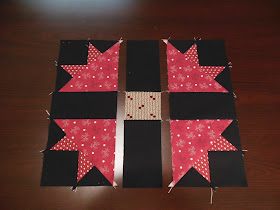Entrepreneur. Creative Force. DIY Ninja. Organizing Fiend. Lover of all things quilty and maker of traditional quilts and wearable art. National Educator; engaging quilt lecture speaker; award winning machine quilter; author and pattern designer.
 Cut 2 squares of gold print (background) and then cut on the diagonal twice.
Cut 2 squares of gold print (background) and then cut on the diagonal twice.
 I start with the triangles. This one is a bit tricky to keep organized the correct way as it is easy to sew on the wrong side and end up with the color placement messed up. Piece all of the triangle units at this point. They should look like the top unit in the photo. (Keep in mind that there is a left version and and a right version.)
I start with the triangles. This one is a bit tricky to keep organized the correct way as it is easy to sew on the wrong side and end up with the color placement messed up. Piece all of the triangle units at this point. They should look like the top unit in the photo. (Keep in mind that there is a left version and and a right version.) When adding the triangle unit to the squares make sure that the edges of the triangle unit are aligned to two sides of the square. It is easy to not align them correctly and it will create problems going forward. I make sure that the edges are perfect and then I pin! Sew and press - don't skip the pressing part!
When adding the triangle unit to the squares make sure that the edges of the triangle unit are aligned to two sides of the square. It is easy to not align them correctly and it will create problems going forward. I make sure that the edges are perfect and then I pin! Sew and press - don't skip the pressing part! The same steps are used to add the other triangle unit to the opposite side of the square. Be sure to align both edges of the triangle unit with both edges of the square. Pin and sew a scant 1/4" seam. Press to the dark.
The same steps are used to add the other triangle unit to the opposite side of the square. Be sure to align both edges of the triangle unit with both edges of the square. Pin and sew a scant 1/4" seam. Press to the dark. This is what your triangle units will look like from the wrong side. Notice you can see the intersections on the perimeter of the unit along two edges.
This is what your triangle units will look like from the wrong side. Notice you can see the intersections on the perimeter of the unit along two edges.  If I would have pressed to the light you would see the intersecting seam along the bottom but then the two on the other edges of the triangle would have been hidden. I always go for the most visible option and in this case it came from pressing to the dark.
If I would have pressed to the light you would see the intersecting seam along the bottom but then the two on the other edges of the triangle would have been hidden. I always go for the most visible option and in this case it came from pressing to the dark.  Lay the triangle unit on top of the large triangles and sew a scant 1/4" seam. Take care to "feel" where the seam intersection is along that edge and do your best not to sew the point off. ☺ You can also peek as you come to that part in the seam to make sure you are on the seam side as opposed to the point side as you sew. If you are not clear about this there are plenty of pics in the early block posts about that intersection and how to sew so you don't cut the points off.
Lay the triangle unit on top of the large triangles and sew a scant 1/4" seam. Take care to "feel" where the seam intersection is along that edge and do your best not to sew the point off. ☺ You can also peek as you come to that part in the seam to make sure you are on the seam side as opposed to the point side as you sew. If you are not clear about this there are plenty of pics in the early block posts about that intersection and how to sew so you don't cut the points off. Sew a rectangle to two of the pieced triangle/squares as shown. Press to the dark. Repeat.
Sew a rectangle to two of the pieced triangle/squares as shown. Press to the dark. Repeat.
No comments:
Post a Comment